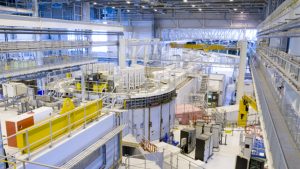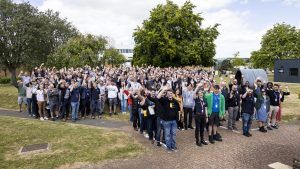From net zero to drug delivery, insights from neutron and muon experiments are helping to tackle some of the most pressing global challenges. The Innovation Platform spoke to Dr Roger Eccleston, Director of the ISIS Neutron and Muon Source, to find out more.
Materials – whether engineering components, pharmaceuticals or computer chips – are the building blocks of our physical world. More than that, they are critical in solving many challenges and improving lives for the global society. In examining materials down to the atomic level, researchers are gaining a better understanding of the world around us and insights to develop new and improved materials with transformational applications. Neutrons and muons are two important probes in the researcher’s toolbox that can explore materials in ways other techniques cannot.
Owned and operated by the Science and Technology Facilities Council (STFC), the ISIS Neutron and Muon Source in Oxfordshire is a world-leading centre for research in the physical and life sciences. Since 1984, the facility has enabled scientists to study materials at the atomic and molecular level using a suite of instruments, each optimised to study different types of matter. Each year, thousands of scientists from the UK and across the world use the ISIS facility to acquire the knowledge needed to tackle major scientific, societal and economic challenges.
As the ISIS Neutron and Muon Source celebrates its 40th anniversary this December, Editor Georgie Purcell spoke to Director Dr Roger Eccleston to learn more about the work that takes place at the facility.
Can you summarise the work of the ISIS Neutron and Muon Source and the centre’s main objectives?
The ISIS Neutron and Muon Source is a particle accelerator that produces very intense beams of neutrons and muons. The way these particle beams interact with materials can reveal their structure and behaviour down to the atomic level.
ISIS is a multidisciplinary research centre that attracts scientists from UK universities and businesses, as well as international researchers. Each year, ISIS hosts around 3,000 researchers from over 30 different countries and conducts an average of 1,200 experiments across a broad range of fields, from quantum mechanics to cultural heritage.
Our main objective is to push the boundaries of knowledge while delivering important economic and social impact. This means addressing key global challenges in areas such as climate change, healthcare, engineering, computing and more. We also prioritise fundamental and blue-sky research, recognising that breakthroughs that improve our understanding of the Universe often translate into technologies and solutions that benefit society.
How can research using neutrons and muons help to impact and improve lives?
The breadth of research undertaken at ISIS is immense but our core strengths lie in the areas of energy, environment, healthcare, engineering and quantum materials.

© STFC
Fundamentally, neutrons and muons allow us to explore materials in unique ways. For example, they can penetrate deep into objects, even within large and complex sample environments under extreme pressures and temperatures. Neutrons are also sensitive to light atoms, like hydrogen and lithium, which enables researchers to obtain detailed information on systems ranging from plant cells to solar cells. For example, in the drive toward net zero, tracking elements like hydrogen and lithium helps us better understand and therefore improve battery technologies. At ISIS, we have a dedicated team working to reduce dependence on some of the metals that make battery materials costly and hazardous.
In healthcare, ISIS is supporting research into a wide range of drug delivery systems. One example is the lipid nanoparticle technology used in mRNA COVID-19 vaccines, which is being explored for a wide range of treatments against infectious diseases, cancer and genetic disorders. Neutrons are providing new insights into the structure and function of the lipid nanoparticles to determine how the pharmaceutical payload can be delivered more effectively. Our users are also working to develop hydrogels for drug delivery. Hydrogels can deliver medication, such as HIV and cancer treatments, through the skin at a controlled rate, providing stable, long-lasting and easy-to-administer treatments which could be transformative for regions with limited access to healthcare.
At ISIS, we are also helping to develop safer and more resilient microchips, which are critical in everything from computers and medical devices to aerospace systems. The microchips used in many devices are vulnerable to the effects of particles generated when cosmic rays from space hit the Earth’s atmosphere. Cosmic ray neutron radiation can disrupt the normal operation of electronic systems, including altering a device’s memory or permanently damaging the electronics. Many companies that produce and use microchips want to test the resilience of their products to cosmic neutrons. At ISIS, we can mimic cosmic neutrons, replicating hundreds to thousands of years of natural exposure in a matter of hours. This helps us to understand and build in ways to protect against the effects of cosmic ray neutrons – something that is particularly important for safety-critical applications in the transport and aerospace sectors.

© STFC
ISIS celebrates 40 years in December. How are you marking this event?
We’re incredibly proud to celebrate 40 years of the ISIS Neutron and Muon Source. Throughout the year, we have held many events to highlight the contributions and achievements of our staff and user community. This has included a series of Science Roadshows, which were held in Belfast, Cardiff, Edinburgh, Manchester and London. These have been research-focused meetings, providing a great way to celebrate the work of the people who use the ISIS facility.
We’ve also held several staff events to recognise the talent and dedication of the people that are, and have been, critical to ISIS’s success. At our summer celebration, staff contributed to an anniversary time capsule created by ISIS technicians using parts from the ISIS machine. The contents will give future staff a glimpse into some memorable moments of the past 40 years — and a few inside jokes!


Looking ahead, we are hosting a special guest lecture at the Rutherford Appleton Laboratory to reflect on past achievements and the exciting future ahead. The anniversary itself, which falls on 16 December, will be a time to celebrate with colleagues, reflecting on the events of the past year and marking 40 years since the first neutrons were produced at ISIS.
For me, this anniversary has not only been a chance to celebrate the achievements of the last 40 years, but also an opportunity to acknowledge ISIS’s global reputation and our ambitious plans to continue to develop the facility into the future.
Can you share some examples of some standout achievements from these 40 years?
This is a question that I’ve been reflecting on throughout the year.

© STFC
When the first high-temperature superconductors were discovered back in the 1980s, not long before ISIS began operating, ISIS contributed to some of the early work to determine the structure of those materials. We also carried out unique work around buckminsterfullerene molecules (‘buckyballs’) in the 1990s, investigating the structure and dynamics of these fascinating molecules.
Since then, our research programme has only grown in breadth and complexity. More recent examples include work on quantum spin liquids, with potential applications in computing and communications, and studies on the mechanisms of antibiotics. These experiments highlight the immense scope and capabilities of the source and instruments, as well as the diverse impact of the research undertaken at ISIS.
A major achievement has been building a vibrant community of researchers who use neutron and muon techniques to do incredible science. It’s also remarkable that, after 40 years, ISIS remains a world-leading research facility. When ISIS started, we quickly established ourselves as an exemplar neutron and muon source. Facilities in Japan, the US and China drew inspiration from the ISIS facility, and despite growing competition, we remain outstanding in both the volume and impact of our research. This success is due to the dedication of our teams, our global partnerships, our users and our continued focus on innovation.
What has 2024 looked like for the facility?
This year has been a time of celebration and reflection with great pride on what has been achieved. It has also been a year of ambition as we progress the Endeavour Programme – a ten-year, £93m project that will see us significantly upgrade and expand our instrument suite. As part of the programme, we are building four new instruments and undertaking major upgrades to five existing instruments. This will ensure we are adding new capability whilst continuing to stay very much in the vanguard of neutron and muon techniques globally.

© STFC
We also have ambitious plans beyond Endeavour. This includes further instrument developments, as well as planning for the next generation of neutron source that we might develop over the next 10-20 years. Certainly, there is much excitement and optimism around the future of ISIS, building on the expertise and capabilities developed over the past 40 years.
What are your key priorities for the near future?
As always, a key priority is making sure we’re supporting our users to do great science. This drives our approach to developing the machine, instruments and accompanying facilities to ensure that we are operating reliably and at a high level, and that we’re providing excellent support for our users.
We’re also focused on pushing forward with new developments and translating our ambitious ideas into reality over the coming decades. The next 40 years at ISIS look incredibly promising, and we’re excited to continue advancing our capabilities and expanding the impact of our research.
Copy edited by Stephanie Richardson, ISIS Communications and Impact Lead
Please note, this article will also appear in the 20th edition of our quarterly publication.





